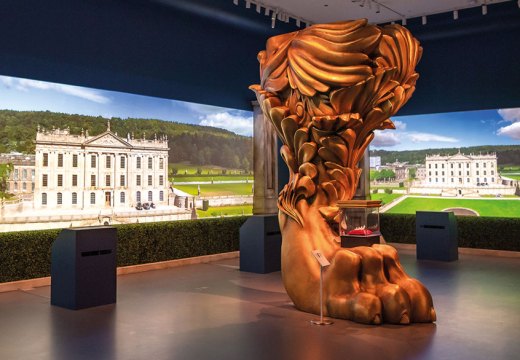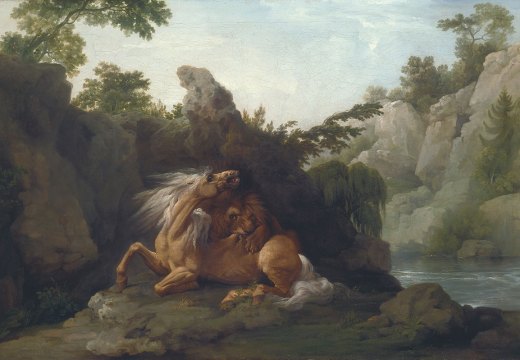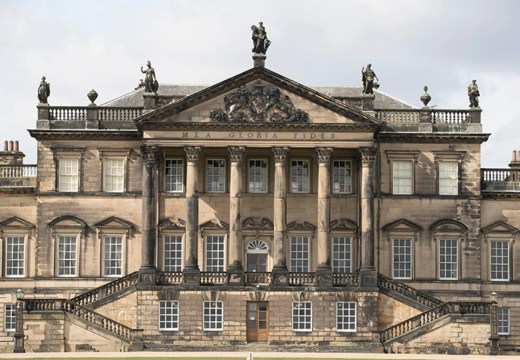In one of the long, painstaking shots of George Stubbs’s paintings being dismounted, boxed and unboxed that form the mainstay of Brooklyn-based artist Amie Siegel’s recent film Bloodlines, we glimpse a tattoo on the calf of one of the art handlers. He is carefully removing a painting from the wall – in its gilt frame, a romantic portrait: Stubbs’s Lady Reading in a Wooded Park (1768–70). She is shaded by a canopy of trees, her downcast eyes marking her activity as solemn. The workman’s leg is inked with a Mexican sugar skull – a calavera de azúcar, ornate offerings presented to the deceased on the Day of the Dead – and an image that’s now been troped into a hackneyed emblem of nothing-in-particular by the face paint of young people out on a Halloween bender.
The cast of labourers in this film, whether the art handlers or those who work on the estates themselves, act like silent witnesses (their speech, the only real talk in the film, arrives late as lowkey, practical chatter relating to the work itself) as though maintaining the conscience of a film intent on ‘revealing systems of class and inherited wealth and subtly suggesting colonialism’s role in establishing and perpetuating their structures’, as its gallery text states. Disrupting the eerie quiet of these stately homes merely by how they look – one of the workmen is a Black man sporting a beanie hat, while the tattoo-bearer has a short-back-and-sides haircut and goatee – they force these reliquaries into confrontation with the modern world they herald.

Installation view of Bloodlines (2021) by Amie Siegel. Photo: Richard Ivey; courtesy the artist and Thomas Dane Gallery; © Amie Siegel
This seems to be the film’s central argument: the past deforms the present. Vectors of our history, in all its iniquity, these objects on their journey to and from the Stubbs retrospective at MK Gallery in Milton Keynes in 2019 both focus and warp our relationship with this still-present past. In country houses such as Goodwood, the National Trust property Upton House or the Spencer family seat Althorp House – places where Stubbs’s paintings have generally been inherited by the descendants of their 18th-century commissioners – it takes an American’s estrangement from Britain’s absurdity to paint it precisely.
And yet there is, in this context, something odd and unsatisfyingly evasive about the film’s performance of chin-stroking – its posture of disinterested perusal – when its title, its choice of subject matter and its playful, knowing mockery of these comically unchanged locations make its meaning, however wryly couched, quite plain.
The textures of this film are anything but plain, however. They are sumptuous and decadent, as they are across Siegel’s film works, which typically trace the lifespan of commodities. Seeming to borrow from Stubbs’s anatomical precision and fealty to nature, the camera portrays, with dazzling visual acuity (shot by drone in 4K resolution), the dew rising in sheets from pastures of mewling flocks of sheep and skies of pallid greys and teals. Meanwhile, in the country homes, where the threadbare curtains match the drapes, wallpaper and the bedding, jacquard damasks and fleur-de-lis enamels appear frozen in their faded opulence.
Terriers, spaniels, retrievers: the leitmotif of the estate’s dogs, perching on the crested porters’ chairs of baroque drawing rooms, call up an uncomfortably biological Stubbsian vocabulary of breeding and refinement that implies an aristocratic urge to hybridise and subdue. An especially out-of-breath Labrador prods at this process as one of inbreeding as much as of pedigree. They are mirrored through footage of tchotchkes, taxidermy and ceramic figurines, bringing the inert world of artefacts into confrontation with the flesh-and-blood landscape of our moral lives. (Liverpool-born autodidact Stubbs cuts a double figure here, documenting this genteel world without being from it in portraits which, like Siegel’s own, bring to bear the outsider’s veracity.)

Installation view of Bloodlines (2021) by Amie Siegel. Photo: Richard Ivey; courtesy the artist and Thomas Dane Gallery; © Amie Siegel
These long, controlled shots often seem poised to erupt into something more menacing; an implicit violence scarcely allowed to surface. This slowness sometimes feels deliberately intense: in languid footage of a painting of reclining cheetahs, eyes wide as though pleading for motion; or in the camera’s recurring roll over a lady making an ‘O’ sign between her thumb and forefinger, clasping a delicate stem – a signal that seems to anticipate the racial malevolence of this symbol’s use by the alt-right.
About a third of the way through, as mustard- and vermilion-jacketed gentlemen stride out on horseback over the open fields, attended by hounds hungry for blood, this tension begins to mushroom into something more barefaced: they live among us, it seems to say. Later, we wander onto a photoshoot (Tatler, or so we imagine) in a marble atrium, where a model straddles a dappled stallion while the photographer bleats out her exhortations, a silly scene which lances the mood. At other times, though, its stilled sequences feel slack, above all in the paintings’ effortful boxing and unboxing, where the film’s montage strikes more as listing accumulation than formal technique.
Adrian Searle, in conversation with Siegel at the ICA in June, referred to her portrait as one of a ‘world in aspic’ – and it is. But the hold these bloodlines exert on the right to construct cultural and national memory has been being destabilised for some time – and with some success, it would seem, or the culture warriors in Whitehall wouldn’t be so scared about Colston’s toppling, or Rhodes Must Fall, or the National Trust’s steps to rake over its colonial heritage.
Watching the film in its setting at the plush Thomas Dane Gallery in St James, there may be ironies about our continued collective collusion in these structures that still need unpacking. Our political moment shows us how successfully this retrograde bank of images continues to mint a sense of aspiration, at the expense of our shared humanity and common future. Nor should we be complacent about sustaining momentum in decolonising our public institutions; the term’s easy use belies the difficulty of its process.
But our world is not in aspic; it is being forced into ongoing struggle over the question of cultural commemoration. Perhaps what we need now is something slightly sharper and more rigorous to consider, where the surfaces are coterminous with the depths, as the necessary and discomfiting work of disturbing this history gathers its fine steam.
‘Amie Siegel: Bloodlines’ is at Thomas Dane Gallery, London, until 23 July. The film is also showing in ‘New Arrivals: From Salvador Dalí to Jenny Saville’ at the Scottish National Gallery of Modern Art (Modern One) , Edinburgh, until 4 September.
Unlimited access from just $16 every 3 months
Subscribe to get unlimited and exclusive access to the top art stories, interviews and exhibition reviews.














![Masterpiece [Re]discovery 2022. Photo: Ben Fisher Photography, courtesy of Masterpiece London](http://www.apollo-magazine.com/wp-content/uploads/2022/07/MPL2022_4263.jpg)
Has the Fitzwilliam lost the hang of things?